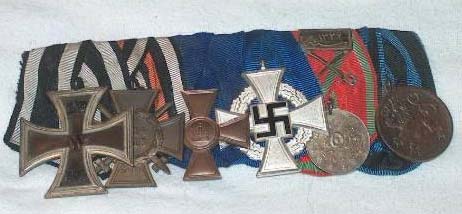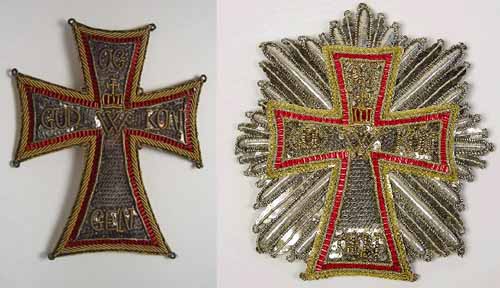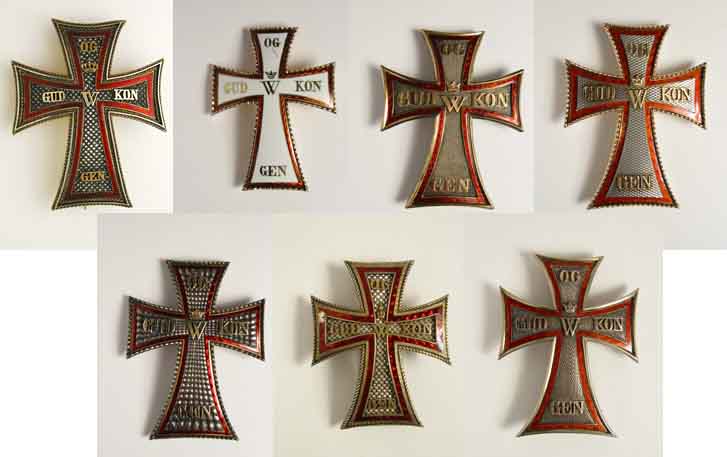-
Posts
1,211 -
Joined
-
Last visited
-
Days Won
8
Content Type
Profiles
Forums
Blogs
Gallery
Events
Store
Posts posted by Great Dane
-
-
Hello gentlemen,
I have a US Bronze Star (part of a mounted group) which has two small patches of that blue-green stuff that often is seen on copper (verdigris?).
What is the best method to get rid of it (I'm afraid of leaving it there, as it might 'grow')?
What causes it?
I tried to remove some of it with just a soft cloth. It got a little better but after a few weeks it was the same as before (and I don't live in a particular moist climate).
So before I move on to more drastic methods, I thought I'd better ask the experts.
Thanks in advance,
/Mike
0 -
Thanks for the 'pointers'. I understand your concern about not being a book salesman.
I'm not planning a collection in this area - just being curious. Knowledge is power, and it's always nice to be able to tell an original from a copy

/Mike
0 -
Thank you for the fascinating "How it all began" story. It's an area that I admit I know absolutely nothing about.
Are there any "How to tell the originals from the fakes" books out there?
/Mike
0 -
Hi Paul,
It's a bit hard to read, but doesn't it say "... und Hansestadt Hamburg"?
So my guess would be Hamburg (obviously
 )
)/Mike
0 -
Anyone saved some pictures from the 1813 EK auctions - #665, #666, #668?
/Stefan
Sure did. Do you want the picture by PM? (it's about 600KB).
/Mike
0 -
Rick,
If you're referring to lot no. 193:
"Sachsen. Milit?r St. Heinrichs-Orden. Ritterkreuz, Silber vergoldet und emailliert, mit band im verleihungsetui"
then the hammer price was 1050 Euros.
/Mike
0 -
So the Baden 'umbrella' part is actually original?
/Mike
0 -
But if he died in the crash in 1944?
/Mike
0 -
0
-
A very nice award indeed

I'm not sure it's for 'rings' though. As far as I know, Ringen (in German) is a form of Greek-Roman wrestling.
What is the letter before 'Ringen' in the engraving? Is it "I."?
/Mike
0 -
Thanks for the feedback guys,
The lists I'm reading are lists of Danish recipients. Since Denmark was neutral during WWI and apparently played a role as a 'POW area' (arranged by the International Red Cross), that could explain the generous amount of Red Cross medals awarded by various nations.
That extraordinary situation would also (I think) justify the neglection of Paragraph 4, as Rick mentions.
OK, let's get back to showing some Red Cross bars

/Mike
0 -
Bob, Chris,
Very nice bars

The pictures lead me to a question:
When browsing through my lists of people who received orders and medals, I have often noticed that many recipients (actually 9 out of 10) of the Prussian Red Cross medal received both the 2nd and 3rd class and wore them both.
I assume that wearing them both were allowed of course, but how come they were so often awarded together?
Was some kind of automation involved (like when you were awarded a high ranking Russian order, you were automatically awarded lower classes of lower ranking orders)?
/Mike
0 -
I just watched the 90 min. James Cameron documentary about the Bismarck on TV (2 days ago). I was so fascinated that I immediately ordered it on DVD

/Mike
0 -
Sorry to intercept the thread, but just for your information:
The bar below just sold for approx. $200.
I have no idea if this is the going rate or dirt cheap?
/Mike

 0
0 -
I did a little more research on my posting #19:
The pilots name was Karl Gunnar Lindner. He was one of the aviation pioneers from the pre-WWII era. Among his highlights were:
- 1928: Flying a Junkers W 33 together with German Baron von H?nefeld in an attempted round-the-world flight. They reached Berlin-Sofia-Constantinople-Bagdad-Karachi-Calcutta-Mandalay-Hanoi-Canton-Shanghai-Tokyo, where they gave up due to bad weather.
- 1934: First flight Stockholm - Hannover. Lindner and his radio-operator had to bail out of the plane.
- 1938: First flight Stockholm - Moscow. The only passenger in the Junkers Ju-52 was the Japanese ambassador in Moscow.
- 1939: First flight Bromma (Sweden) - Perth (Scotland).
What a shame to split this group!

The seller was from somewhere in South America (Brasil?). Maybe Lindner ended his days down there?
It was obvious from the description of the stuff on eBay, that the seller did not split it up to get a higher profit, but just had absolutely no idea what it was or who it had belonged to

/Mike
0 -
I have just read this interesting thread, and spotted a medal bar at a local internet auction that would fit in it.
I'm not considering buying it since it's not my field (and I don't need more slippery slopes...
 ), but I was just curious what the experts comments are.
), but I was just curious what the experts comments are.(Sorry, the picture below is the only one I have)
/Mike

 0
0 -
I remember on one occasion earlier this year where a medal on eBay caught my eye. It was a medal awarded to a swedish pilot in the late 1930s. (Now, remember that this isn't my primary field of interest, so the details are a bit rusty now. I did, however, research it a bit at the time).
It turned out to be a group of medals, orders and badges awarded to one of the pioneers of Swedish aviation (I have forgotten his name unfortunately
 ), who flew one of the first non-stop flights to Tokyo in the late 1930s. There was a connection with Germany, but I can't remember if he started from Germany or had a German co-pilot.
), who flew one of the first non-stop flights to Tokyo in the late 1930s. There was a connection with Germany, but I can't remember if he started from Germany or had a German co-pilot.Among the medals were named Japanese medals in gold, named and unnamed Swedish decorations and aviation badges and even an Order of the German Eagle.
At the time I spotted the auction, 7-8 items were sold separately. All the auctions had a picture showing all his awards, and that made me curious. Sure enough - looking at the seller's history, several badges and medals had already been sold. Of the Order of the German Eagle there was no trace...
And - yes- all the items had different buyers...
This splitting up of such a historical important group really broke my heart...

/Mike
0 -
And here is my collection of... no... wait... I don't have anything that can compete with THAT!

/Mike
0 -
Here are two of my embroidered stars. Both are almost mint condition, and were probably replaced with privately made metal stars right away.
I bought the Grand Cross on the right last week, so hopefully it's in the mail...

/Mike

 0
0 -
Yup, I saw that one already. Now, if only I had 45.000+ Euros...

One thing puzzles me with this lot:
Ewald must have received the Grand Cross of the Order of Dannebrog after 1808, when the Grand Cross embroidered star had the new legend in the picture (before 1808 the legend was RE STI TU TOR on the four cross arms). But the reverse of the Grand Cross badge shows the cypher of Frederik IV who ruled 1699-1730! Thus when Frederik IV died, Ewald wasn't even born!
(The reverse of the badge is on another picture in the catalog).
Very strange...

/Mike
0 -
Dave,
Regarding your Officer's cross, Christian X:
The knight class was not divided into Officer and Knight until 1952, and King Christian X died in 1947. However a lot of Knight cross holders didn't like the idea of being 'pushed one step down', so they mounted a rosette on the ribbon to symbolize the former one-class Knight class

/Mike
0 -
Nice items

Inspired by the thread, here is some from my own collection. Denmark was one of the last countries in Europe to abandon the embroidered crosses/stars (as late as 1909), so most receipients hade metal stars privately made. These privately made stars are of course not obliged to be returned.

 0
0 -
I commented the bar with a German dealer/collector who said that it wasn't to him very appealing, because such aristocrats had several medal bars being made for wearing in different occasions or on different uniforms. Is it true?
I'm not an expert on German Royalty, but I know that among other European crowned heads, it was normal to have 'copies' (or just more than one original) of different decorations. That way they could wear a mounted group that fitted the occasion instead of remounting the whole group every time.
Typical groups would be the complete group, a 'light' version with the most important orders/decorations and a 'local' version with the national orders/decorations/medals.
In many countries it is normal to (just) wear your local orders and the orders of the country of your guests. I saw one guy (a prince if I remember correctly) who had 'localized' his orders into smaller groups. Whenever he needed to wear his orders, he just mounted the appropriate smaller groups closely together so they would appear as one large group fitting the occasion.
/Mike
0 -
I can add one from my own collection:
The embroidered star from the Danish Vall? Monastery (virgins of noble heritage only
 ). The decoration was instituted in 1783.
). The decoration was instituted in 1783./Mike

 0
0




How to remove 'green stuff' from a Bronze Star?
in Preservation & Restoration of Military Artifacts
Posted
Thanks for all the suggestions.
Someone once recommended using WD-40, but since that treatment also involved "and then you just polish it until it is nice and shiny" I didn't want to go down that road...
Sounds like the softened toothpick is worth a try. Maybe the 'secret' is to remove ALL of it, so that it doesn't grow back...?
I'll give it a go...
Thanks gentlemen,
/Mike